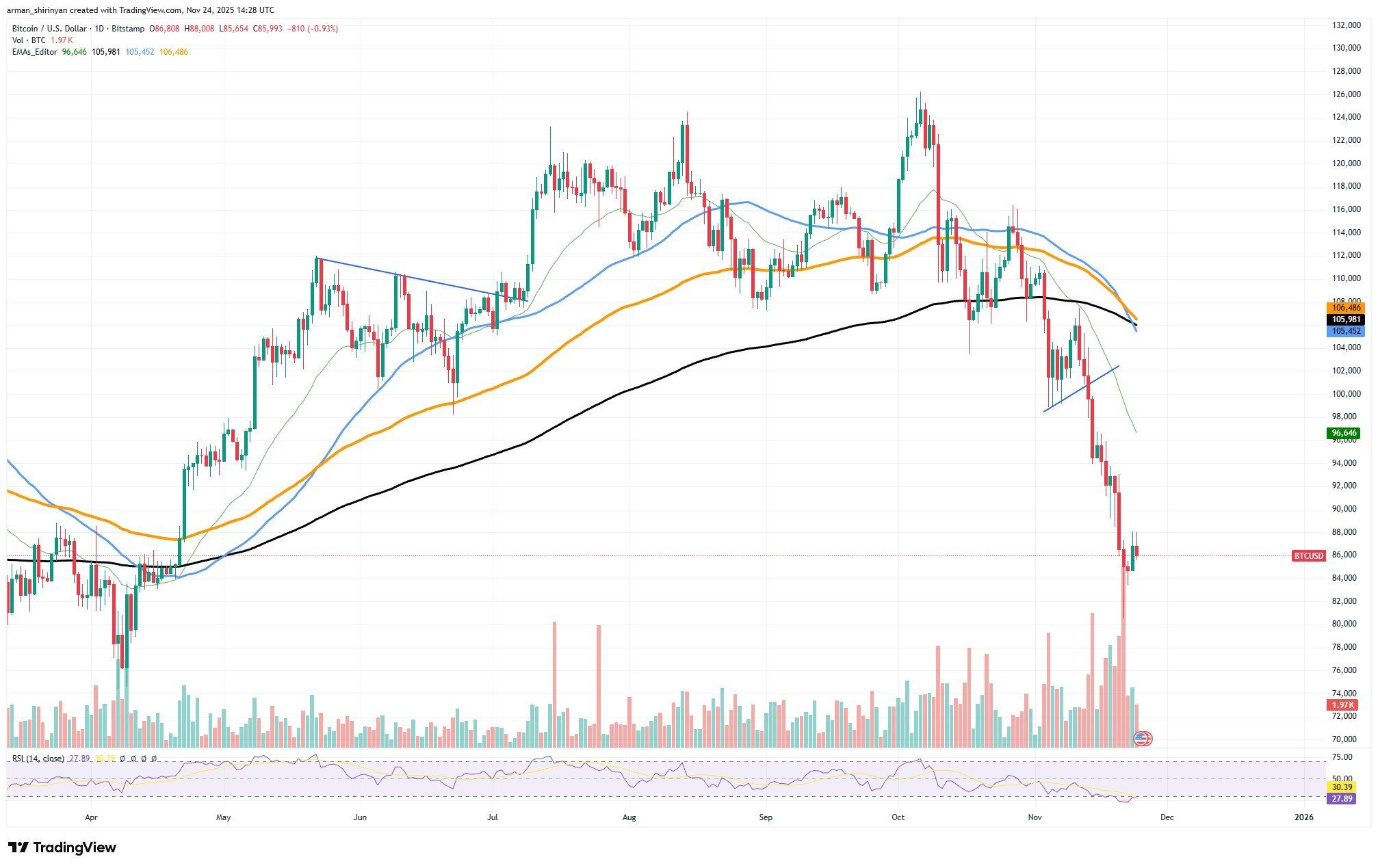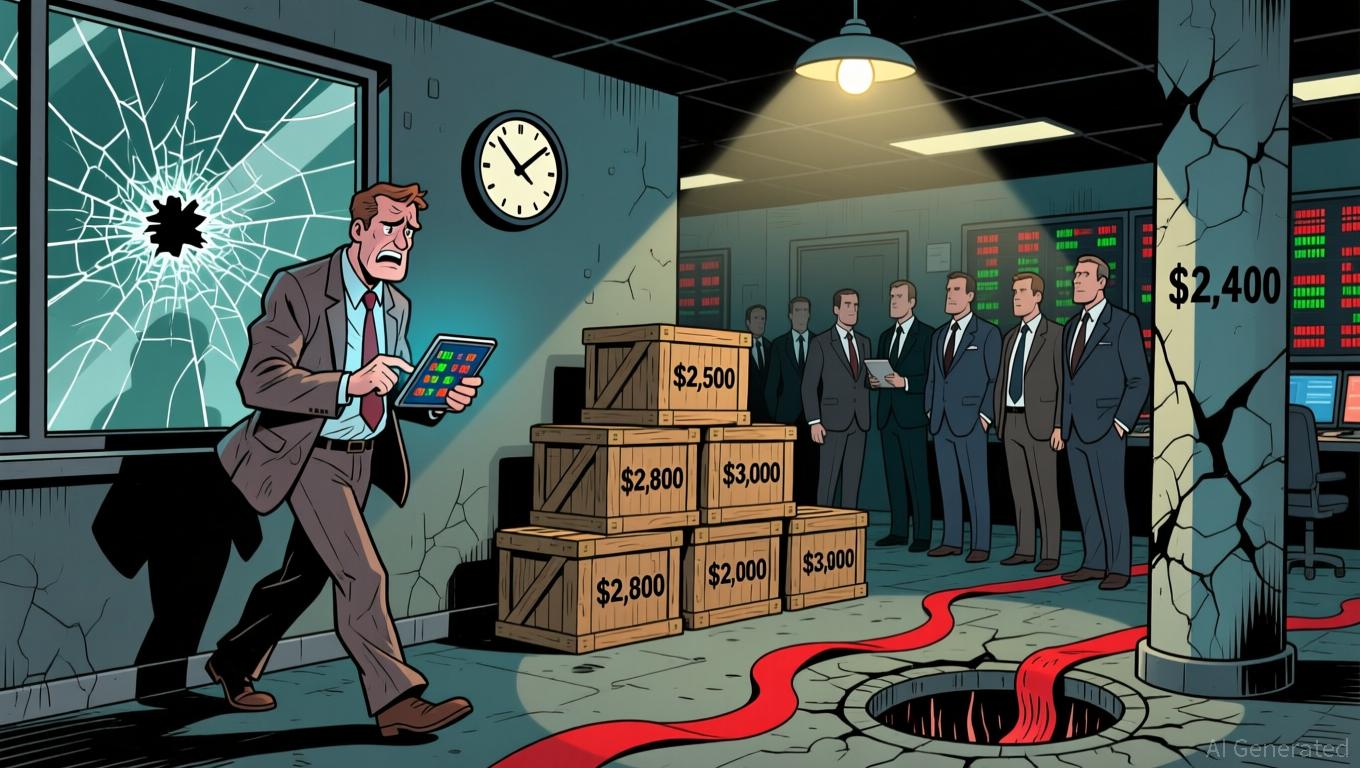Crypto Market Prediction: $1,400,000,000 Bitcoin (BTC) Carnage Over, Ethereum (ETH) Crash Might Not Stop, Shiba Inu (SHIB) Market Collapse Ending
There is not much to hope for from a cryptocurrency when you see how troublesome the whole situation is: Bitcoin is slowing down after multibillion carnage among institutional and retail investors, Ethereum's crash is only gaining momentum and it seems like Shiba Inu is bottoming out.
Bitcoin running out of fuel
It appears that the $1.4 billion liquidation wave of Bitcoin has finally run out. The market printed the first real indication of seller fatigue following a straight-line decline that drove Bitcoin from the $110,000 area into the mid-$80,000s: a sharp recovery off oversold conditions combined with a noticeable slowdown in sell volume.
It usually takes a structural catalyst or a final capitulation flush to reset sentiment when the market gets this stretched. This instance was the latter. The damage is evident on the chart: Bitcoin easily cut through its 20-, 50- and 100-day moving averages. Every attempt at an intraday rally was thwarted by aggressive selling as momentum turned sharply bearish.

Additionally, buyers are intervening for the first time since the decline started, as seen by the long wicks near the bottom. The behavior of Bitcoin in this stabilization zone will determine what happens next. The worst of the chaos is probably over if Bitcoin can stay above the $83,000-$85,000 range. From this point on the price usually moves in the direction of retesting the broken moving averages, which are currently in the $96,000-$105,000 range.
First the 20-day and then the 50-day. This does not imply an instantaneous V-shaped reversal, but when sellers lose control, a grind higher is the normal course. A secondary retest of the lows poses the greatest risk. It becomes a classic bottom structure if the volume is lower and the floor is not broken.
BTC returns to the mid-$70,000s if it breaks. However, it appears that the market has finally released its selling pressure as of right now, and the $1.4 billion purge may have been the capitulation event required to reset the trend.
Ethereum in troublesome position
The one pattern that is beginning to emerge surrounding other significant assets is absent from Ethereum, and this is a problem. Following their capitulation flushes, Bitcoin and Shiba Inu both showed early indications of a rounding bottom, including strong selling, a rebound candle and a curved stabilization, as opposed to a straight rebound. This type of structure occurs when sellers run out of ammunition, and the price starts to bend rather than decline vertically.
However, that curve is absent from Ethereum. Its chart continues to show a steep, nearly linear downslope. Not even leveling. Not a curve. There is no proof that buyers are consciously consuming the supply. That is the initial red flag.
Without hesitation, ETH broke below all of the major moving averages, including the 20-, 50-, 100- and even 200-day, but it has not produced the kind of rebound candle you would anticipate from a true bottoming attempt. ETH did not react with a proper snap-back, in contrast to BTC and SHIB, even though the RSI hit oversold. The bounce is shallow, feeble and far from creating structure.
The price difference from the declining moving averages is the main cause for concern. Instead of curling back toward them, ETH is sliding beneath them. According to trend logic, trapped longs panic-sell into weakness, which frequently results in a second, sharper drop than the first.
Shiba Inu stabilizes
After weeks of sharp declines, Shiba Inu is now showing the first indications of structural stabilization. Although there is not yet a complete reversal structure, the most recent price action is creating a rounding pattern close to the lows, which is sufficient to indicate that the downtrend may be waning.
This shift was accelerated by the oversold RSI. During the most recent decline, SHIB recorded one of its lowest RSI readings of the year; in the past, these readings have led to brief recoveries. The lack of follow-through sales immediately following oversold levels suggests that sellers are beginning to lose motivation. SHIB would have continued to bleed below the $0.0000075 zone if the trend had remained strong; instead, we are witnessing a slight upward curve.
Investors should anticipate a gradual stabilization rather than an instantaneous V-shaped reversal from this point on. Because they depend on sentiment gradually changing from fear to indifference to cautious accumulation, rounding bottoms take time. Only when the price begins to build higher lows on brief time frames — which seems to be happening right now — does that shift become apparent.
The $0.0000075-$0.0000080 support band should be held. The rounding structure gains credibility and indicates a stop to the downtrend if buyers defend this range. SHIB must recover short-term moving averages before the downward trend reverses.
A close above the 20-day creates room for $0.0000092 to $0.0000100. The real resistance is still the long-term declining trendline between $0.0000105 and $0.0000110. SHIB can only transition from stabilization to recovery with a breakout there.
Disclaimer: The content of this article solely reflects the author's opinion and does not represent the platform in any capacity. This article is not intended to serve as a reference for making investment decisions.
You may also like
Ethereum Updates: Ethereum Drops to $2,800, Prompting Surge in Demand for ZKP's Hardware-Based Presale
- Ethereum's price fell below $2,800, triggering $6.5M liquidations and testing critical support levels amid declining on-chain demand metrics. - Institutional players like BitMine accumulated 3.62M ETH (~$10.4B) despite the selloff, signaling long-term bullish conviction. - ZKP's hardware-driven presale gained traction with $17M in ready-to-ship Proof Pods and Miami Dolphins partnership for privacy-focused sports analytics. - Mutuum Finance's $19M DeFi presale and ZKP's auction model with $50K wallet caps

Vitalik Buterin Supports ZKsync: What This Means for Layer 2 Scaling
- Vitalik Buterin endorsed ZKsync in late 2025, highlighting its "underrated and valuable" work alongside the Atlas upgrade achieving 15,000 TPS and $0.0001 fees. - ZKsync's zero-knowledge rollups and EVM compatibility enabled institutional adoption by Deutsche Bank , Sony , and Goldman Sachs for cross-chain and enterprise use cases. - The Fusaka upgrade aims to double throughput to 30,000 TPS by December 2025, positioning ZKsync to compete with Polygon zkEVM and StarkNet in Ethereum's Layer 2 landscape. -

The ZK Atlas Enhancement: Revolutionizing Blockchain Scalability?
- ZKsync's 2025 Atlas Upgrade achieves 15,000–43,000 TPS with sub-1-second finality, addressing Ethereum L2 scalability bottlenecks via Airbender proofs and modular OS. - DeFi protocols like Aave and Lido leverage ZKsync's $0.0001/tx costs to unify liquidity, while Deutsche Bank and Sony adopt its trustless cross-chain infrastructure for compliance and transparency. - ZK token surged 150% post-upgrade, with TVL hitting $3.3B and analysts projecting 60.7% CAGR for ZK Layer-2 solutions by 2031 amid instituti

XRP News Update: XRP ETFs Spark Optimism—Is $1,115 Within Reach?
- XRP's price surge to $2.20 is driven by ETF launches, with $422M inflows from Franklin Templeton and Grayscale. - Technical indicators suggest a potential $2.50+ rally if support at $1.84 holds, with long-term forecasts reaching $26.50 by 2030. - Institutional adoption of Ripple's ODL and Ripple USD's $1B+ market cap highlight growing utility beyond remittances. - Regulatory clarity post-SEC ruling and macroeconomic factors remain critical for XRP's $1,115 potential in ultra-bullish scenarios.

